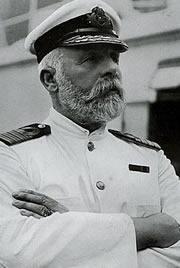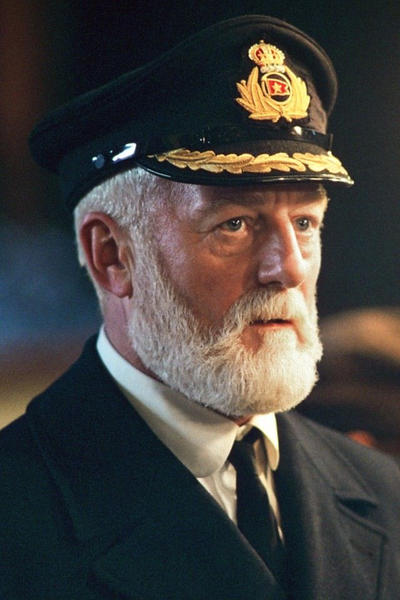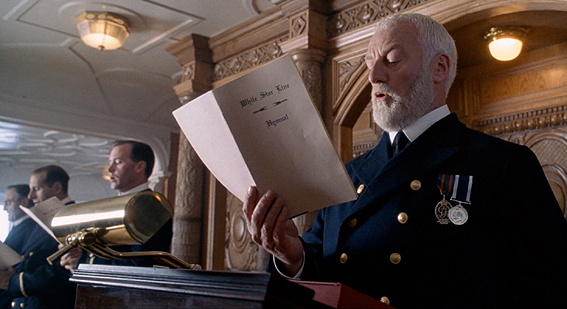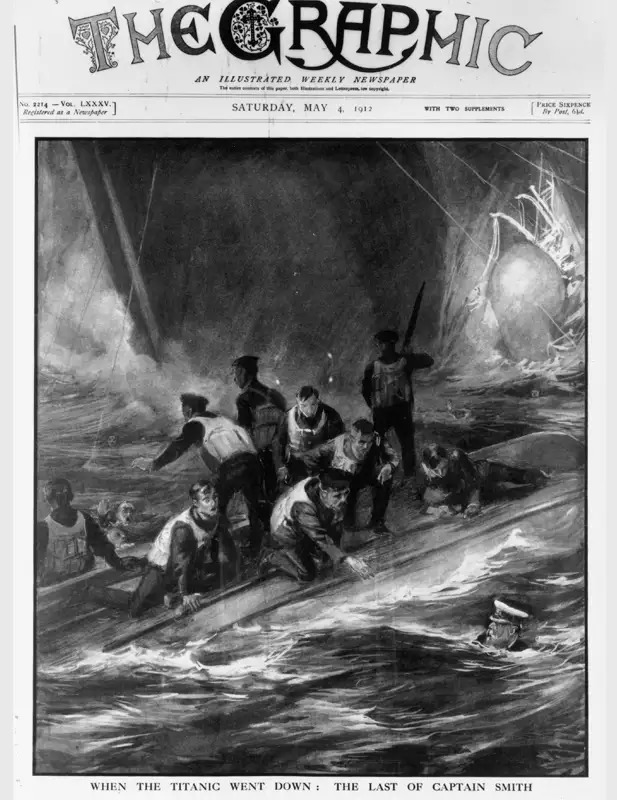Captain Edward Smith


Edward John Smith. One of the most iconic figures of the Titanic disaster. Even if yoy aren't fully invested with the full history of the Titanic, if you were shown a picture of the Captain, you would instantly know who it was. As much, he is depicted in most if not all films based on the Titanic, and the 1997 Titanic film is no exception. In the film, Smith is portrayed by english actor Bernard Hill, who actually resembles him the most out of all the actors who have portrayed him. Hill also gives him a nice pleasant sounding voice, which could be accurate. Surprisingly, there is an account of what Smith sounded like. According to Charles Lightoller, who was the second officer of the Titanic and served under Smith on many ocean liners in the years before 1912, said that, "As a matter of fact, he had a pleasant quiet voice and invariable smile. A voice he rarley raised above a conversational tone-not to say he couldn't; I have often heard him bark an order that made a man come to himself with a bump." Edward Smith was born in Hanley, Staffordshire, England on Januray 27th, 1850. When he attended school until the age of 13, when he left begin his career at sea. Eventually in 1880, he joined the White Star Line, where he quickly rose through the ranks, and became one of the most respected captains on the sea. he became populary known as the "millionaire's captain" becuase most first class passengers spiecvially chose to do passage on a ship commanded by Smith. In April of 1912, Edward Smith was selected to be the Captain of the Titanic, and when the ship sank, Smith went down with the ship.
Now with the movie scenes
The first major scene with Smith is the famous "Take her to sea, Mr. Murdoch." This scene occurs as the Titanic is steaming into the open ocean. In the words of old Rose's narration: "By the next afternoon, we were steaming west from the coast of Ireland with nothing out ahead of us but ocean." Something that happened in real life that is never mentioned in the film is that in real life, after the Titanic departed on it second stop (Cherouberg, France an event depicted in the film), the Titanic made a final stop at Queenstown, Ireland(today known as Cobh) to pick up more third-class passengers.
The scene of Smith commanding the Titanic as it heads out into the open ocean is a pretty accurate representation of what it may have been like on the Titanic's bridge as it headed out. You can tell that his fellow crewmembers held a deep respect for Smith in this scene alone. As Lightoller later said, "He was a great favourite, and a man any officer would give his ears to sail under. I had been with him many years, off and on, in the mail boats, Majestic, mainly, and it was an education to see him con his own ship up through the intricate channels entering New York at full speed."
The next scene with Smith is somewhat controversal. It's between Smith and the president of the White Star Line, Bruce Ismay, and Ismay persaudes Smith to light the last of the Titanic's boilers, so that the Titanic can go full speed. We'll talk about the controversey later, when we discuss Ismay, but what I want to mention when it comes to this scene, is one thing. Ismay says that Smith is going to retire after the Titanic's maiden voyage. This is something that has made it into a lot of retellings of the Titanic's story. Is it true? Well, maybe, but most likely no. In the lead up to the Titanic's maiden voyage, Smith was reported in the press as entering retirement at the end of the return voyage. But on April 10th, 1912 some newspapers reported that Smith would actually not retire, but will be incharge of the Titanic until "a larger and liner vessel" was built. In 1911, for buildup for Olympic's maiden voyage it was reported that Smith would retire at the end of the year. This was later reported as untrue. More than likely, the reports of Smith's retirment was just pre-voyage hype to just muster up first-class ticket sales for people to boast that they were on Smith's last voyage. Nothing more.
Another scene with Smith is in the big dinner scene in the first class dining room. Smith would've dined here. He was very sociable wth the passengers, in fact on the night of the 14th(at 11:40 PM that night, the Titanic hit the Titanic) he attended a dinner party in his honor at the Titanic's A la Carte Resturant.

On sunday Arpild 14th, Smith is seen leading the 10:30 am first-class church service. This actually happened in real life. Smith usually didn't lead service, but in this case he did. Infact, he was actually orginally going to lead a lifeboat drill at 11 am, which was cancelled. In the film, Smith and the first-class passengers sing "Eternal Father". In real life, according to survicor Archibald Gracie, they sang "O God Our Help in Ages Past". The second-class passanger church service were actually the ones who sang "Eternal Father. In case you're thinking that it was negligent of Smith to cancel the lifeboat drill, lookout Archie Jewell said that Smith cancelled it because of high wind.
Later that day, Smith is on the bridge. Rose and her family are having a tour with Thomas Andrews(more on him later). Smith is approached by radio operator Harlod Bride, who gives him a ice berg warning. Smith assures Rose that ice is nothing is worry about, as ice is normal that time of year and that the ship is speeding up. Most people like to say that Smith didn't do anything to prevent the ship from danger. Actually, he did. First off, the ship wasn't going it's full speed. Not all of the ship's boiler's were lit. Also, Smith realized that the ice was a hazard, and ordered that the Titanic go on a much more southernly route to avoid the ice. He didn't slow down the ship, but back then, that's what most captain's did when notified about ice. What Smith didn't know was that the Titanic was now directly in the path of a giant iceberg.
At night at 9, Smith with seen with second officer Charles Lightoller. Smith is seen talking about how the weather and sea is dead calm. Lightoller tries to subtly get Smith to slow down, by saying that the calm weather will make it harder to spot the icebergs. Smith ignores this, and heads off, leaving Lightoller in charge of the watch until the end of his shift, adding while leaving to "maintain speed and heading". Is this how it happened? According to Lightoller's testimony, most of this is accurate. Smith and Lightoller discussed the cold and calm weather, but when Smith left, he told Lightoller that if the conditions change, let him know at once. Smith left the bridge to go to bed, but he knew that at any moment, he would probably be needed. He knew there was oce in the area. But since his cabin was litterally right next to the bridge, if there was any trouble, he would be there at a moments notice.
Right after the Titanic hits the iceberg, Smith is almost instanly seen on the bridge, asking Murdoch what had happened. Murdoch repiles that the ship had hit an iceberg. This scene will be discussed in depth more when we get to Murdoch, but the end where Smith orders that inspections be done. He ordered Officer Boxhall to do inspections, he got the carpenter to do inspections, and he got Thomas Andrews to do inspections, which he assited in, as seen in the film.
In the big scene that is payoff to all the inspections, Smith is with Ismay, Andrews, and the other officers in the chart room, and Thomas Andrews explains to them all that the Titanic is doomed. According to most evidence, this exact set up never happened. Most eyewittneses say that Andrews delivered the news to the Captain in the bridge. There was no big meeting, and orders of what the officers should do went thorugh word of mouth. At this point at 12:25 am, Smith knew that the worst was going to come, and ordered that the lifeboats he swung out.
Next scene afterwards, is Smith giving the order to the radio operators Jack Phillips and Harlod Bride the order to give out the distress signal of C.Q.D. In real life, he told them to remain on standby for any such message. In this scene, he is also shown giving them a postion of where the Titanic is, to send out. This positon that Smith gave them was actually a rough position that Smith had made. Officer Boxhall later gave them a more updated postion.
Not long after this, Smith is approached by Harlod Bride who informs him that the Carpahtia was the closet ship that was responding to the Titanic's messages. He tells him that the Carpthia was going to reach the Titanic in four hours. Not shown in the film, was the fact that there actually was a ship that was 10 milies away from the Titanic. That ship in question was the Californian. It had stopped it's engines because of an ice field. It's lights were actually seen by people on the Titanic, so it was pretty close. It wasn't responding to the messages as the Californian's radio operator had gone to bed. Smith tried to get the Californian's attenion by firing rockets, but the crew of the ship were more puzzled than alarmed by the sight of the rockets, so they didn't do anything.
After the last scene, Smith is approached by Lightoller, who asks him if it's time to get the women and childern into the boats. Smith in a daze, says "Yes, women and childern first." This scene happen in real life, and his vauge order had big consquences. He never clairified what he meant by women and childern first, so the officer's in charge of lowering the boats had different interpetations. Murdoch thought it meant, put women and childern in the boats, then men. Lightoller thought it was women and childern ONLY, and only allowed women and childern. This lead to a lot of empty seats in lifeboats. Also, Smith being in a daze is a very common portryael of his activities during the sinking. Yes it's true that accoridng to many eyewitneses, he did appear to be in one, but what man wouldn't? He knows that most of the people on the ship will die. The shock no doubt got to him. But he did take part in the evactuation, even helping to lower some boats.
One thing he did do, that isn't in the film but was filmed but later cut, was his attempting to get some of the lifeboats to come back. In the deleated scene, he is seen with a megaphone attempting to call back lifeboat 6 back to the ship, so it's empty seats can be filled, but the sailor incharge of the boat refuses to come back. This is something Smith tried to do towards the end around 1:50 am, with little sucess.
Lastly, there is the big famous scene, where Smith goes into the Titanic's bridge just before it goes under. You know the scene. He goes down with the ship. Did this happened? Most likely no. There were plenty of eyewitneses who saw Smith enter the bridge just before the final plunge, but according to people who were closer, Smith was actually with Andrews. Smith told Andrews that it was time for them to abandon ship, and they were last scene jumping from the bridge as it was going under.

In addition, there were survivors on the upside down lifeboat collaspeible b, who claimed that they saw Smith swiming in the waters near them. This might've been wishful thinking on their part, but it is possible considering that he was seen jumping from the bridge.

Although in my opinion, the image of Smith staying in the bridge is so iconic, that it's the perferred image of him.
Overall, I think the film was reasonably accurate to Smith, but it definelty isn't perfect.